Study on Optimization of Tunnel Ventilation Flow Field in Long Tunnel Based on CFD Computer Simulation Technology
Abstract
:1. Introduction
2. Numerical Model
2.1. Model Description
2.2. Geometric Model and Meshing
2.3. Boundary Conditions
3. Results and Validation
3.1. Formation of Main Circulation Air Current
3.2. Study on the Elimination of the Wind Wall
3.3. Research on the Position of Draft Fan
4. Optimization of Air Flow Structure in Gallery Ventilation
5. Discussion
5.1. Site Ventilation Test
5.2. Enlightenment and Limitation of Current Research Work
6. Conclusions
- (1)
- In the tunnel recirculation systems of long twin tunnels, the main air flow of tunnel recirculation systems can be formed by using jet fans arranged at the air flow-in tunnel. The main air flow direction is from the air flow-in tunnel, as the air enters the air flow-out tunnel after passing through the cross-aisle, and is discharged from the air flow-out tunnel is formed. By reasonably selecting the model parameters of the fan, it can be ensured that the speed of the main circulating air flow in the tunnel reaches the minimum wind speed of 0.5 m/s, as required by the specification.
- (2)
- The cross-aisle is where the air flow meets, and the flow field is more complicated. In addition, because the cross-sectional area of the cross-aisle is smaller than the area of the main tunnel, the average air velocity of air flow will increase significantly after the air flow passes through the cross-aisle, resulting in a high-speed wind wall at the exit of the transverse tunnel. Furthermore, there is a whirlpool area at the intersection with the air flow-out tunnel.
- (3)
- Elimination of the obstruction of the wind wall to the air flow out of the tunnel face can be solved by adding a draft fan in front of the cross-aisle. After a draft fan is installed in front of the cross-aisle, it can effectively improve the air flow pattern and change the flow direction of the high-speed air flow. Therefore, the contaminated air at the tunnel face can better converge into the main wind flow of the tunnel and the vortex problem caused by the high-speed air flow behind the cross-aisle is solved, effectively avoiding the accumulation of polluted gas.
- (4)
- When the induced draft fan is close to the exit of the cross-aisle, it is easy to generate a vortex between the induced draft fan and the cross-aisle, which will affect the speed of the air flow out of the tunnel face. Studies have shown that when the distance between the induced draft fan and the cross-aisle is 20 m, it can effectively improve the air flow pattern, so that the wind speed in the tunnel can reach about 1.5 m/s, which can meet the requirements of ventilation and dust prevention and reduce harmful gas accumulation.
Author Contributions
Funding
Institutional Review Board Statement
Informed Consent Statement
Data Availability Statement
Conflicts of Interest
References
- Liu, R.; He, Y.; Zhao, Y.; Jiang, X.; Ren, S. Tunnel construction ventilation frequency-control based on radial basis function neural network. Autom. Constr. 2020, 118, 103293. [Google Scholar] [CrossRef]
- Liu, R.; Ren, S.; Fan, J.Y.; Wu, F.; William, N.T. The air flow structure and gas dispersion behavior in gas tunnel construction through bench cut method. Therm. Sci. 2019, 23, 1417–1424. [Google Scholar] [CrossRef]
- Ye, F.; Qin, N.; Liang, X.; Ouyang, A.; Qin, Z.; Su, E. Analyses of the defects in highway tunnels in China. Tunn. Undergr. Space Technol. 2021, 107, 103658. [Google Scholar] [CrossRef]
- Chen, Q.; Zhang, H.; Zhu, Y.; Chen, S.; Ran, G. Study on distributions of airflow velocity and convective heat transfer coefficient characterizing duct ventilation in a construction tunnel. Build. Environ. 2020, 118, 107464. [Google Scholar] [CrossRef]
- Xu, T.; Zhao, D.; Tao, H.; Lei, P. Extended CFD models for numerical simulation of tunnel fire under natural ventilation: Comparative analysis and experimental verification. Case Stud. Therm. Eng. 2022, 31, 101815. [Google Scholar] [CrossRef]
- Yin, S.; Nie, W.; Guo, L.; Liu, Q.; Hua, Y.; Cai, X.; Cheng, L.; Yang, B.; Zhou, W. CFD simulations of air curtain dust removal effect by ventilation parameters during tunneling. Adv. Powder Technol. 2020, 31, 2456–2468. [Google Scholar] [CrossRef]
- Li, S.; Liu, X.; Wang, J.; Fang, G.; Chen, W.; Deng, S. Reduced Scale Experimental Study and CFD Analysis on the Resistance Characteristic of Utility Tunnel’s Ventilation System. Energy Procedia 2019, 158, 2756–2761. [Google Scholar] [CrossRef]
- Nakayama, S.; Uchino, K.; Inoue, M. Analysis of Ventilation Air Flow at Heading Face by Computational Fluid Dynamics. Shigen Sozai 2011, 21, 55–64. [Google Scholar]
- Parra, M.T.; Villafruela, J.M.; Castro, F.; Mendez, C. Numerical and experimental analysis of different ventilation systems in deep mines. Build. Environ. 2006, 41, 87–93. [Google Scholar] [CrossRef]
- Wang, X.L.; Zhang, Z.Q.; Zhou, Z.Y.; Chen, H.C. Numerical simulation of TBM construction ventilation in a long diversion tunnel. Tunn. Undergr. Space Technol. 2011, 26, 560–572. [Google Scholar] [CrossRef]
- Xiu, Z.H.; Nie, W.; Yan, J.Y.; Chen, D.W. Numerical simulation study on dust pollution characteristics and optimal dust control air flow rates during coal mine production. J. Clean. Prod. 2020, 248, 119197. [Google Scholar] [CrossRef]
- Zhou, Y.; Yang, Y.; Mao, Z.L.; Bu, R.W.; Gong, J.H.; Wang, Y.X.; Yi, L. Analytical and numerical study on natural ventilation performance in single- and gable-slope city tunnels. Sustain. Cities Soc. 2019, 45, 258–270. [Google Scholar] [CrossRef]
- Shokofe, R.; Majid, A.; Hasan, M. Investigating impact of gas emission uncertainty on airflow distribution in an auxiliary ventilation system using CFD and Monte-Carlo simulation. Build. Environ. 2021, 204, 108165. [Google Scholar]
- Zhang, H.; Sun, J.; Lin, F.; Wang, L. Optimization on energy saving ventilation of gallery-type combined construction shaft exhaust in extra long tunnel. Procedia Eng. 2017, 205, 1777–1784. [Google Scholar] [CrossRef]
- Fang, Y.; Fan, J.; Kenneally, B. Air flow behavior and gas dispersion in the recirculation ventilation system of a twin-tunnel construction. Tunn. Undergr. Space Technol. 2016, 58, 30–39. [Google Scholar] [CrossRef]
- Özakin, A.N.; Kaya, F. Effect on the exergy of the PVT system of fins added to an air-cooled channel: A study on temperature and air velocity with ANSYS Fluent. Sol. Energy 2019, 184, 561–569. [Google Scholar] [CrossRef]
- Hao, Z.; Gorlé, C. Quantifying turbulence model uncertainty in Reynolds-averaged Navier–Stokes simulations of a pin-fin array. Comput. Fluids 2022, 209, 104641. [Google Scholar] [CrossRef]
- Shen, Y.M.; Ng, C.O.; Zheng, Y.H. Simulation of wave propagation over a submerged bar using the VOF method with a two-equation k–ε turbulence modeling. Ocean Eng. 2004, 31, 87–95. [Google Scholar] [CrossRef]
- Malikov, Z. Mathematical model of turbulence based on the dynamics of two fluids. Appl. Math. Model. 2020, 82, 409–436. [Google Scholar] [CrossRef]
- JTG-2005; Technical Specifications for Construction of Highway Tunnel. CCCC First Highway Group Co., Ltd.: Beijing, China, 2005.
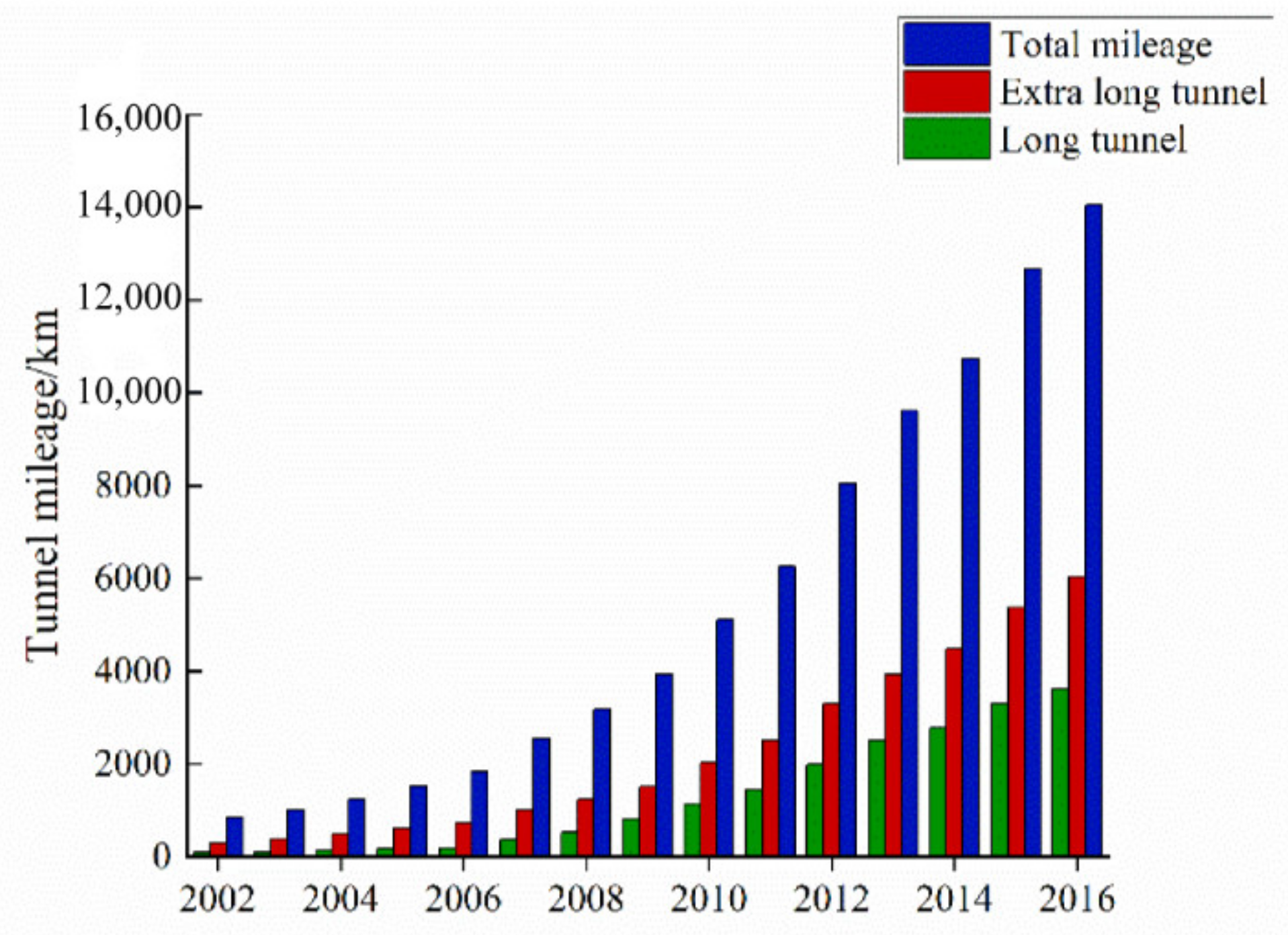

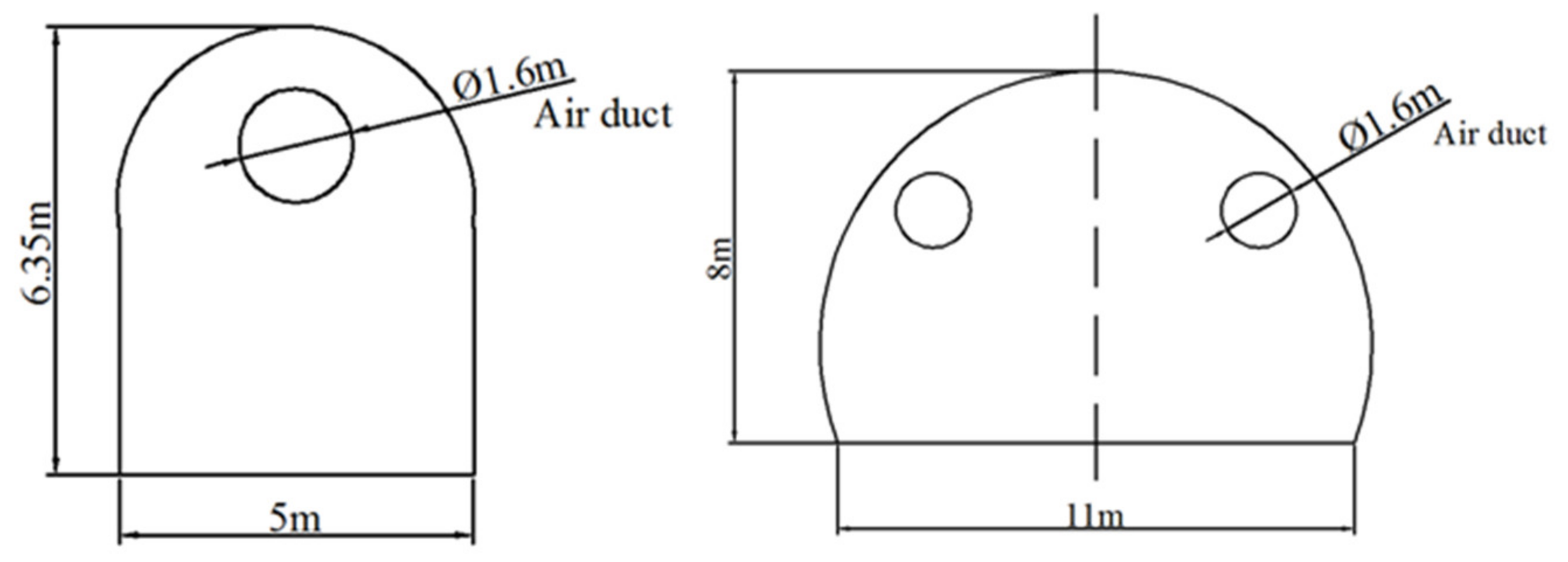
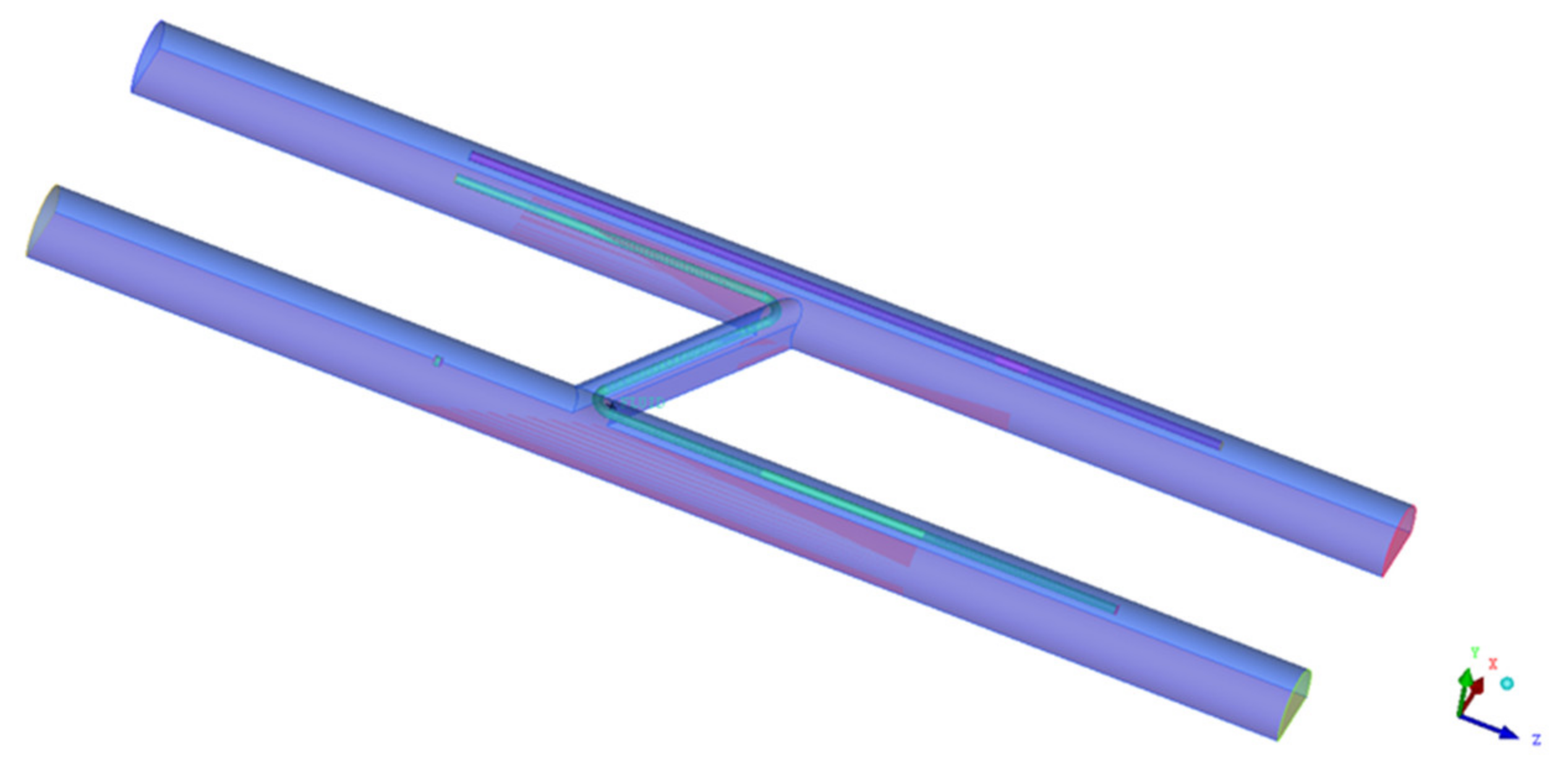
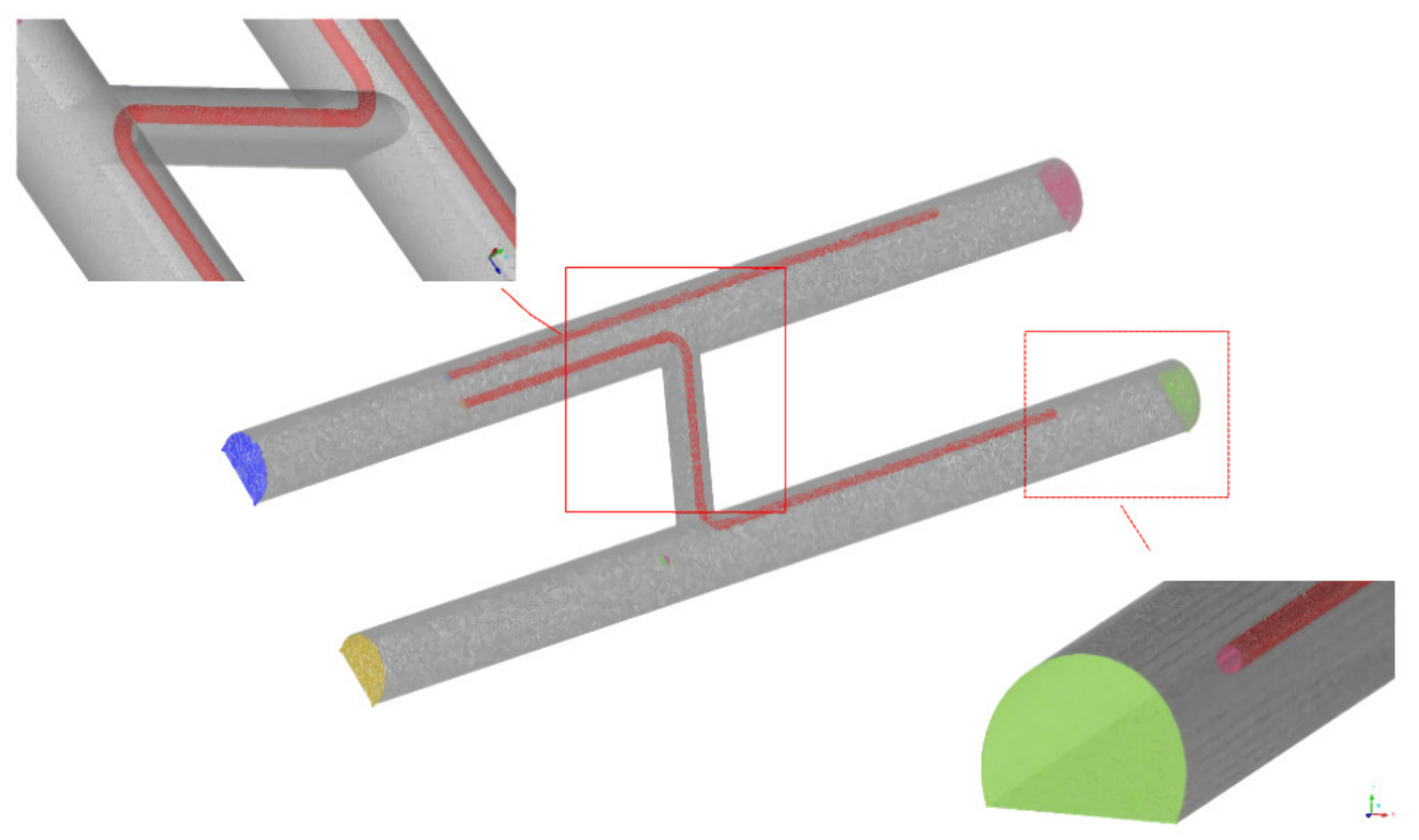
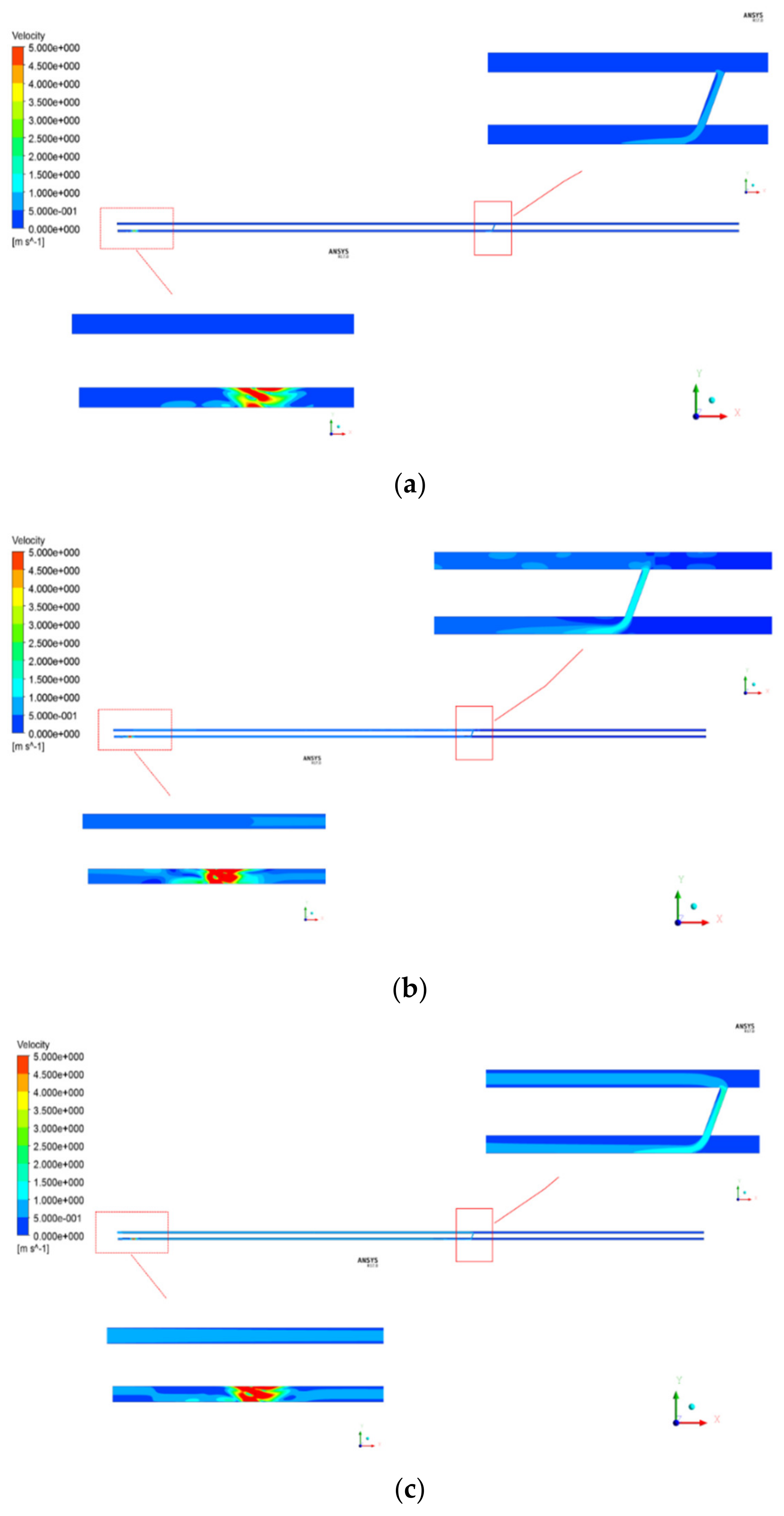
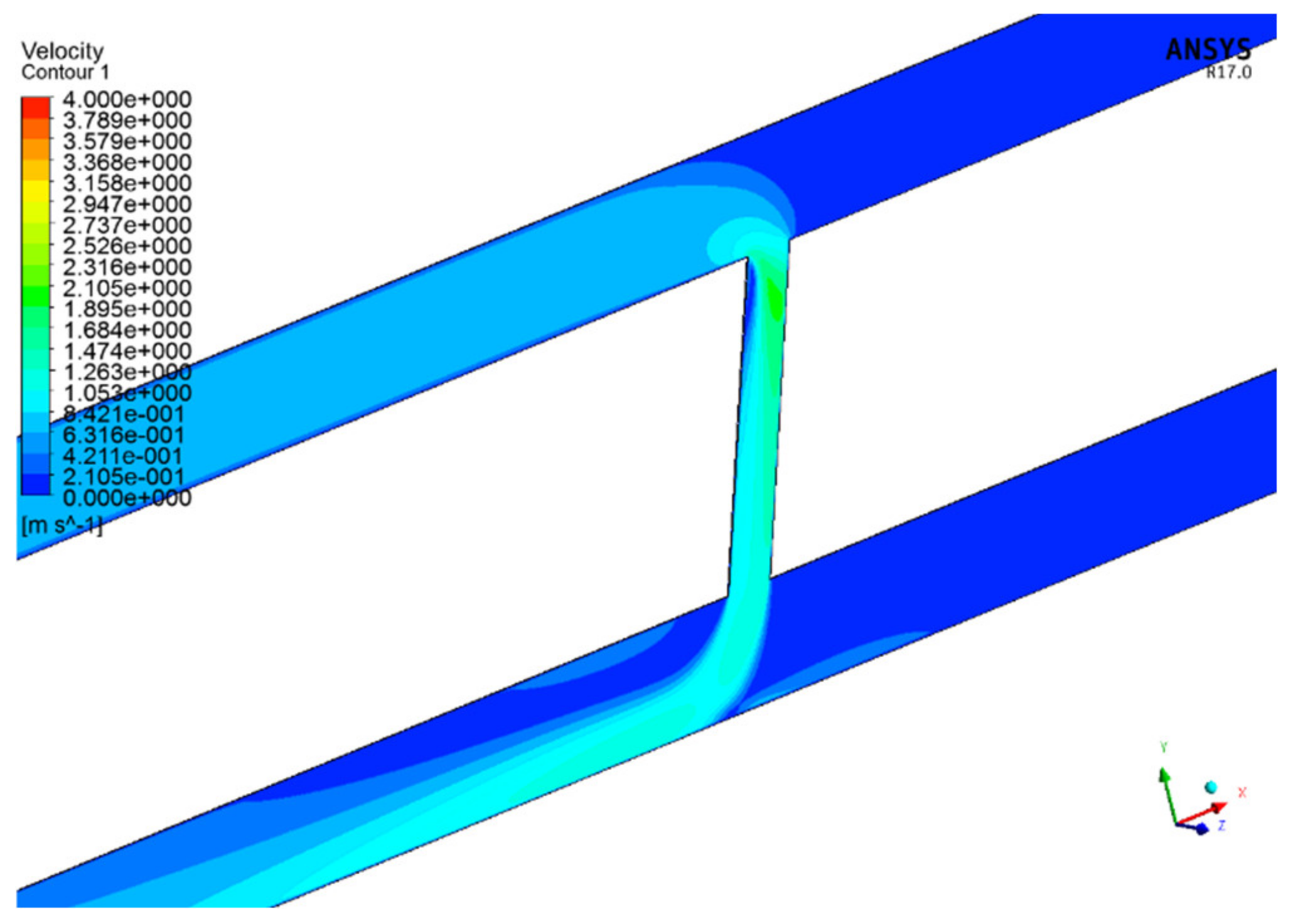
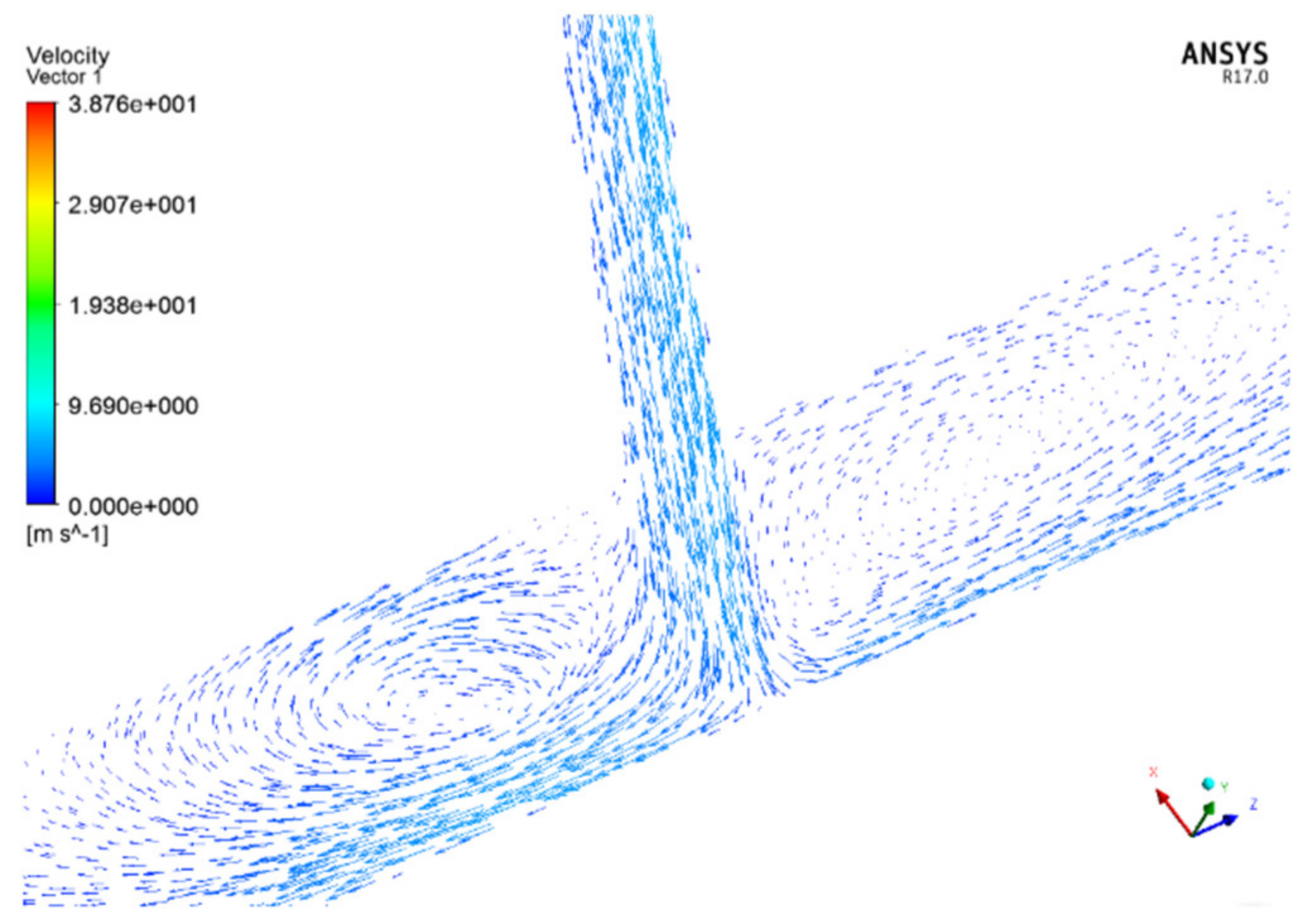
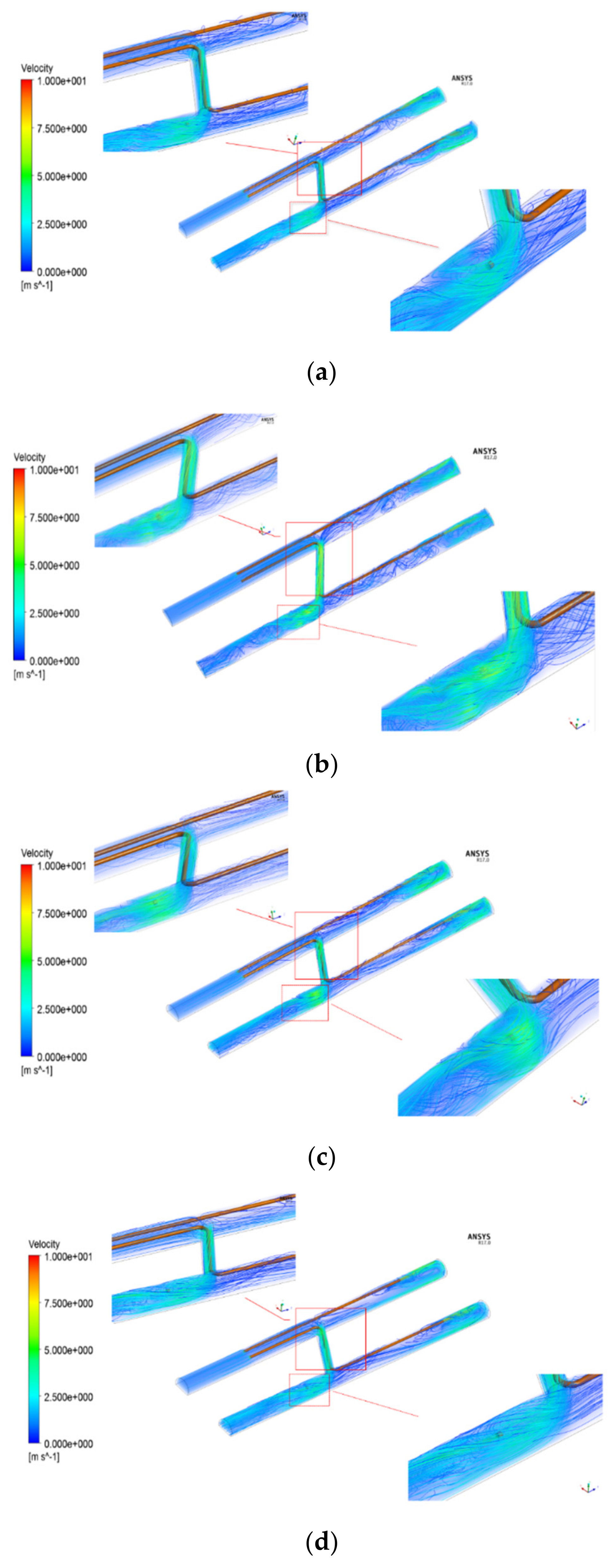
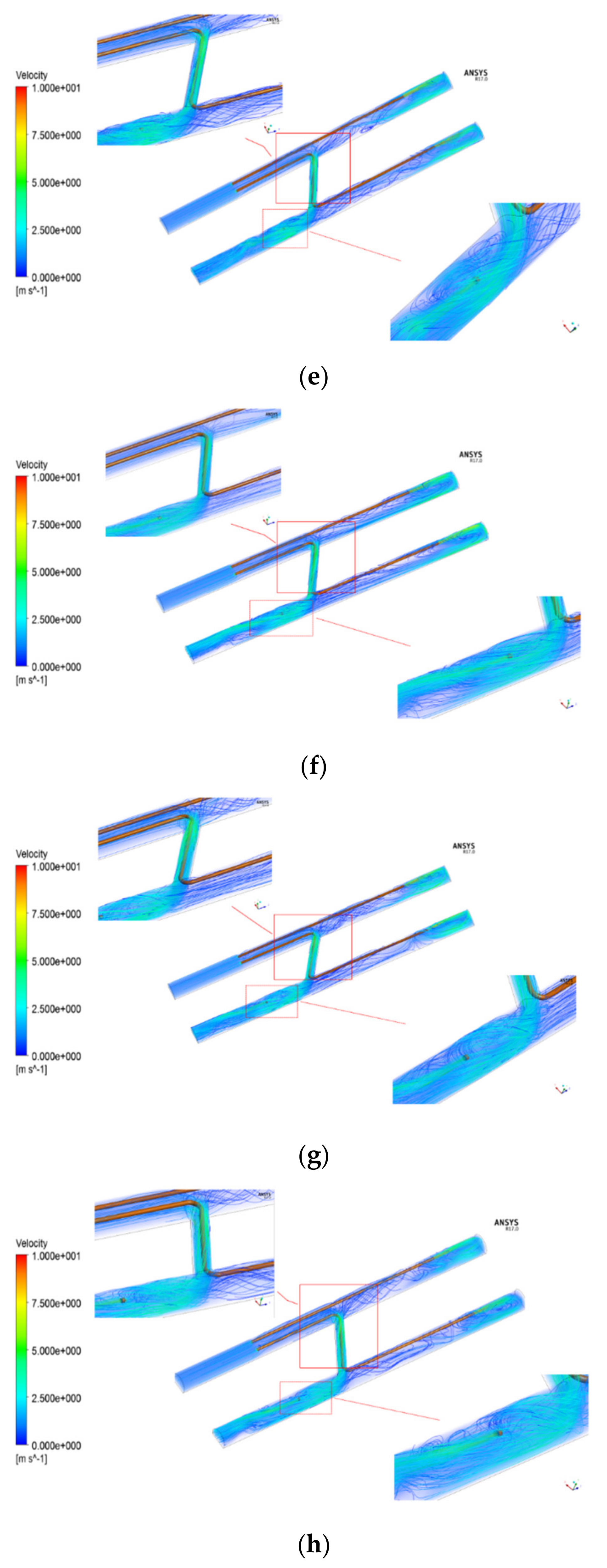

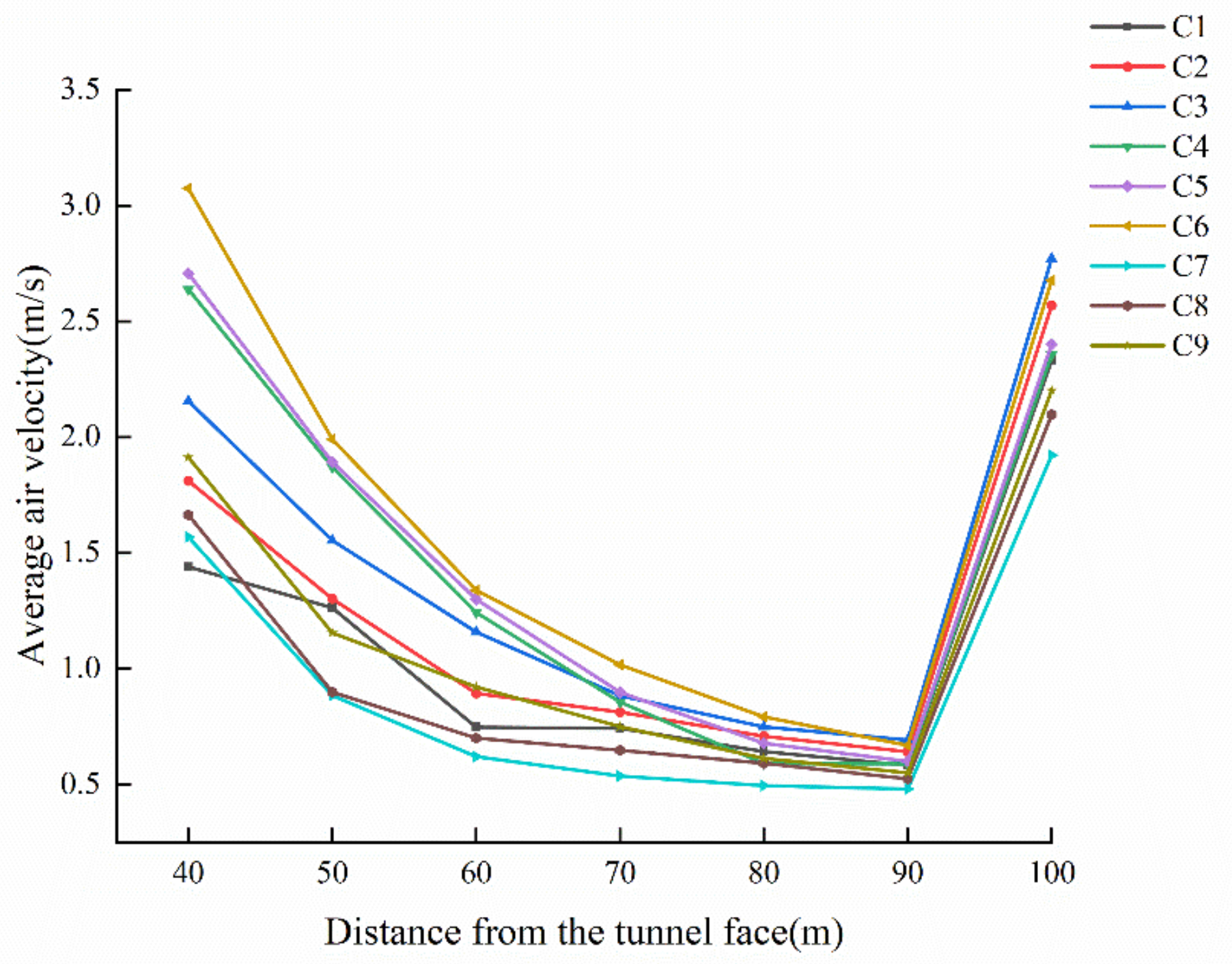

| Name | Type | Value/Property |
|---|---|---|
| Genera | Solver type Gravity | Pressure-based 9.81 m/s2 |
| Cell zone conditions | Operating pressure | 101,325 Pa |
| Viscous model | Temperature k-epsilon Near-wall treatment | 298.15 k Realizable k-ε Standard wall function |
| Air | Yplus Density Viscosity | (65 < yplus < 245) 1.225 kg/m3 1.789 × 10−5 kg/(m·s) |
| BC: wall | Wall motion Shear condition | Stationary wall No slip |
| BC: air duct outlet | Velocity-inlet | Velocity magnitude(m/s) 20.6 m/s |
| BC: jet fan | Fan | 200 pa, 300 pa, 400 pa |
| BC: tunnel outlet | Pressure-outlet | 101,325 pa |
| BC: tunnel inlet | Velocity-inlet | 0.5 m/s |
| Working Condition | I | II | III | IV | V |
|---|---|---|---|---|---|
| 200 Pa | 0.2159 m/s | 0.2965 m/s | 0.3759 m/s | 0.6958 m/s | 2.0369 m/s |
| 300 Pa | 0.4631 m/s | 0.4953 m/s | 0.6078 m/s | 0.9965 m/s | 2.4396 m/s |
| 400 Pa | 0.9356 m/s | 0.9880 m/s | 1.0325 m/s | 1.3236 m/s | 3.5678 m/s |
| Working Condition | Fan Model | Distance between the Draft Fans and the Exit of the Cross-Aisle |
|---|---|---|
| C1 | 200 Pa | 10 m |
| C2 | 300 Pa | 10 m |
| C3 | 400 Pa | 10 m |
| C4 | 200 Pa | 20 m |
| C5 | 300 Pa | 20 m |
| C6 | 400 Pa | 20 m |
| C7 | 200 Pa | 30 m |
| C8 | 300 Pa | 30 m |
| C9 | 400 Pa | 30 m |
| Working Condition | Safety Factor | Working Condition | Safety Factor | Working Condition | Safety Factor |
|---|---|---|---|---|---|
| C1 | 0.76 | C2 | 0.74 | C3 | 0.81 |
| C4 | 0.80 | C5 | 0.78 | C6 | 0.88 |
| C7 | 0.79 | C8 | 0.83 | C9 | 0.85 |
Publisher’s Note: MDPI stays neutral with regard to jurisdictional claims in published maps and institutional affiliations. |
© 2022 by the authors. Licensee MDPI, Basel, Switzerland. This article is an open access article distributed under the terms and conditions of the Creative Commons Attribution (CC BY) license (https://creativecommons.org/licenses/by/4.0/).
Share and Cite
Yang, S.; Ai, Z.; Zhang, C.; Dong, S.; Ouyang, X.; Liu, R.; Zhang, P. Study on Optimization of Tunnel Ventilation Flow Field in Long Tunnel Based on CFD Computer Simulation Technology. Sustainability 2022, 14, 11486. https://doi.org/10.3390/su141811486
Yang S, Ai Z, Zhang C, Dong S, Ouyang X, Liu R, Zhang P. Study on Optimization of Tunnel Ventilation Flow Field in Long Tunnel Based on CFD Computer Simulation Technology. Sustainability. 2022; 14(18):11486. https://doi.org/10.3390/su141811486
Chicago/Turabian StyleYang, Song, Zubin Ai, Chao Zhang, Shun Dong, Xun Ouyang, Rong Liu, and Ping Zhang. 2022. "Study on Optimization of Tunnel Ventilation Flow Field in Long Tunnel Based on CFD Computer Simulation Technology" Sustainability 14, no. 18: 11486. https://doi.org/10.3390/su141811486




